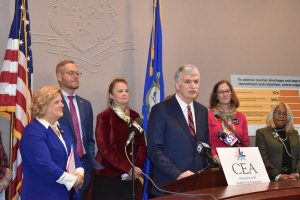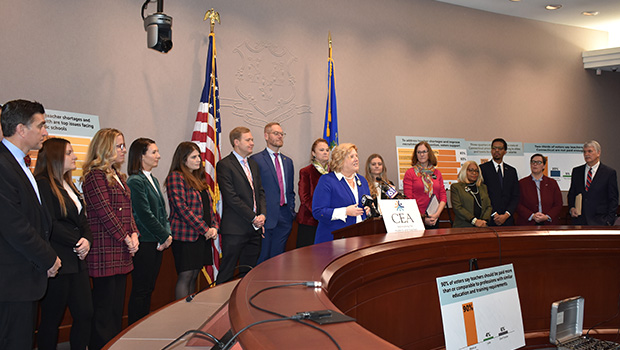While Connecticut is experiencing a public education crisis that includes a crippling teacher shortage, the state has both the capacity and overwhelming voter support to turn that around.
That was the key message at a morning news conference where CEA released findings of a new survey exploring Connecticut residents’ views on public schools and teachers and underscored voters’ desire to prioritize education this legislative session.
The survey found, among other things, that widespread teacher burnout and shortages are among the top education concerns for the state’s registered voters and that strong support exists for a wide range of proposals to mitigate those concerns—including higher pay and a secure retirement for teachers, more school funding, and additional resources for students’ mental health.
Community concerns, consensus

CEA President Kate Dias answers reporters’ questions about CEA’s latest survey.
“Our communities recognize that teachers are not getting the salaries that professionals with commensurate responsibilities and education are earning,” said CEA President Kate Dias, adding, “We are at that moment where we either make a decision to invest in and uplift this profession or we continue to watch our public school teachers look for a better offer. Good public schools draw families and businesses to this state, so teachers are a phenomenal investment. This is a moment of opportunity. We have the opportunity to right this ship.”
“The issues our members have raised are issues that voters clearly agree with,” said CEA Vice President Joslyn DeLancey, pointing to several of the survey’s findings. “What this shows us is that Connecticut knows that investing in education is important. We have the opportunity to be creative and make positive, proactive changes.”
Among the survey’s findings:
- 90% of voters say teachers’ compensation should be comparable to or higher than professions with similar education and training requirements
- Three-quarters of voters favor more state funding to cities and towns for teacher salaries
- 71% of voters believe teachers who worked during the height of the COVID-19 pandemic should receive “hero pay” or other compensation for that work
Legislative support
Joining CEA leaders at the news conference were more than a dozen Democratic and Republican legislators, including House Speaker Matthew Ritter, Education Committee Chair Jeff Currey, Education Committee Ranking Member Kathleen McCarty, CEA members Kevin Brown and Chris Poulos, and fellow representatives Hector Arzeno, Robin Comey, Michelle Cook, Dominique Johnson, Sarah Keitt, Jennifer Leeper, Corey Paris, Moira Rader, and Mary Welander.

Speaker Matt Ritter (center) and Education Committee Chair Jeff Currey (left) pledge to elevate public education and the teaching profession this legislative session.
Rarely have so many legislators ranked the Education Committee as their number-one preference for committee assignments, said Ritter, who expressed his commitment to fixing a special education system that unfairly saddles municipalities with costs he believes the state has a moral obligation to cover.
“Connecticut should make sure that all kids, no matter where they live, know the state is supporting them and their educational pursuits and not leaving it to cities or small towns that can’t afford it.”
Improving education, he said, also means addressing school indoor air quality, reducing class sizes, and supporting teachers—for whom the pandemic gave parents such as him a renewed appreciation.
“I could not be more excited to know that stepping into this legislative session, education is a top priority for every single caucus in this building,” said Currey. “I just came from a Connecticut Conference of Municipalities event in which every leader of every caucus got up, and education was the first thing out of their mouth.”
He added, “Teachers are professionals. They are due respect, because they are trained and educated to teach our children day in and day out, often spending more time with them than their own families have the ability to. Let’s focus on that this session, and let’s get it right. It’s going to take every legislator and everyone advocating. I really appreciate CEA and all of the information they’ve provided to make sure we’re moving forward in a direction that is going to be positive for the students, educators, and families of Connecticut.”

Education Committee Ranking Member Kathleen McCarty acknowledges educators’ tremendous responsibilities and value.
“We have to elevate the teaching profession to the level our teachers deserve and look at all the proposals CEA is outlining for us—the salaries, retirement, and class sizes,” McCarty agreed. “From my very first entry into the legislature, I believed all children are due a quality education, and that means equitable funding throughout the state. But we can’t do any of the work in education unless we have teachers in the classrooms.”
McCarty acknowledged the tremendous responsibilities, stress, and anxiety heaped on teachers since the beginning of the pandemic and urged her colleagues to build upon the work of recent General Assemblies to make education their top priority.
Back to the future
A similar groundswell of support for teachers decades ago resulted in meaningful change that turned a profession plagued by dire shortages into a respected career choice.

CEA Executive Director Donald Williams stresses the importance of reinvesting in our teachers, as Connecticut did with the Teacher Enhancement Act of 1986.
“I’m reminded of the Teacher Enhancement Act, passed in 1986 and implemented in 1987,” said CEA Executive Director Donald Williams. “What a difference that made. The legislature joined together—Republicans and Democrats, in a bipartisan effort—to lift up not only teaching but public education in general. They invested over a billion dollars, adjusted for inflation, to increase teachers’ salaries and support public schools for the benefit of students across the state. We desperately needed that at the time, and I would argue that we are in a very similar place in 2023. Teacher salaries have fallen behind, students’ needs are greater than ever, and attracting new educators is more critical than ever. We do that by investing. There aren’t many occasions where the existence of great challenges and needs corresponds with the availability of resources to fully meet those challenges and needs. We have that today.”
Speaking for the next generation of educators, CEA Aspiring Educators Program Vice Chairs Kate Cummings and Marlee Greenlaw offered, “As the future teachers of Connecticut, we have firsthand experience with the issues preventing youth from entering this profession.” Many students hoping to become educators, they explained, face hurdles that include the financial difficulties of extra test fees and unpaid student teaching as well as the stress of succeeding at edTPA teacher assessment.

Aspiring educator Kate Cummings tells lawmakers, “We are the future, we are listening, and we will be watching the legislative session closely.”
“College classrooms are full of students who would like to become teachers, yet there is still a teacher shortage,” Cummings said. “Education must be at the top of the agenda this legislative session not only for current teachers but for the aspiring educators as well. We are the future, we are listening, and we will be watching the legislative session closely.”
Also speaking at the news conference were AFT Connecticut Vice President for PreK-12 teachers Mary Yordon and AFT Connecticut Vice President for Paraprofessionals and School-Related Personnel Shellye Davis, who called for shrinking what’s known as the teacher pay penalty—the 20% disparity between teachers’ pay and that of their college-educated peers—and supporting the paraeducators who work alongside classroom teachers and who are also in short supply throughout the state.
Watch the entire news conference here and see highlights on Channel 3, 8, 30, and 61 newscasts. (Click here for additional media coverage.)







